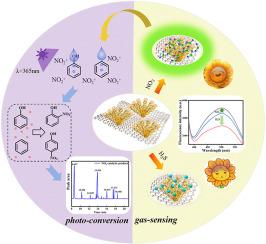Development of bifunctional coal graphene–COF hybrids for acidic gas probe and catalytic conversion
IF 11.6
2区 材料科学
Q1 CHEMISTRY, PHYSICAL
引用次数: 0
Abstract
Exploring a candidate with integrated capabilities of gas sensing– adsorption– conversion was great potential to minimize air pollution and global warming. In this study, a novel coal graphene–covalent organic framework (CG-H4bptc-COF) with the bifunctionality of gas sensing and catalytic conversion was developed. The CG-H4bptc-COF was synthesised using coal graphene (CG) as a carrier through a solvothermal reaction between 3,3,5,5-biphenyl tetracarboxylic acid (H4bptc) and 2,4,6-tris (4-aminophenyl)-1,3,5-triazine (TAPT). The obtained CG-H4bptc-COF show fluorescence characteristics in organic solvents owing to large conjugated π-bonds formed between the H4bptc and TAPT building blocks cooperation. In an ethanol/dichloromethane mixed solvent, CG-H4bptc-COF exhibited an extinguishable fluorescence response upon NO2 (enhanced), H2S (quenched), and SO2 (unchanged) injection owing to variations in intramolecular hydrogen bonds and the protonation of the triazine rings. Within the detection ranges from 100 ppb to 100 ppm and from 1 ppb to 100 ppm, CG-H4bptc-COF exhibited enhanced and quenched fluorescence emission for NO2 and H2S, respectively, with RSDNO2=RSDH2S = 1.70 %–3.40 %, LODNO2 = 4.47 ppm and LODH2S = 2.82 ppm. In a static gas adsorption process, higher amounts of NO2 and H2S were adsorbed. Moreover, in a benzene/phenol mixed solvent, CG-H4bptc-COF catalysed the NO2 into nitro compounds (70 % yield), despite its mass loss during the catalytic conversion process. Therefore, bifunctional CG-H4bptc-COF operates both a gas sensor and catalyst for optical sensing and air purification.

用于酸性气体探测和催化转化的双功能煤石墨烯- cof杂化物的研制
探索一种具有气体传感吸附转化综合能力的候选材料对减少空气污染和全球变暖具有很大的潜力。本研究开发了一种具有气敏和催化转化双重功能的煤石墨烯-共价有机骨架(CG-H4bptc-COF)。以煤石墨烯(CG)为载体,通过3,3,5,5-联苯四羧酸(H4bptc)与2,4,6-三(4-氨基苯基)-1,3,5-三嗪(tpt)的溶剂热反应合成CG-H4bptc- cof。所得的CG-H4bptc-COF在有机溶剂中表现出荧光特性,这是由于H4bptc和tpt之间形成了较大的共轭π键。在乙醇/二氯甲烷混合溶剂中,由于分子内氢键的变化和三嗪环的质子化,CG-H4bptc-COF在NO2(增强)、H2S(淬灭)和SO2(不变)注入下表现出可熄灭的荧光响应。当RSDNO2=RSDH2S = 1.70% - 3.40%, LODNO2 = 4.47 ppm, LODH2S = 2.82 ppm时,CG-H4bptc-COF在100 ppb ~ 100 ppm和1 ppb ~ 100 ppm检测范围内,对NO2和H2S的荧光发射分别增强和猝灭。在静态气体吸附过程中,吸附了大量的NO2和H2S。此外,在苯/苯酚混合溶剂中,CG-H4bptc-COF尽管在催化转化过程中损失了质量,但仍能将NO2催化成硝基化合物(产率为70%)。因此,双功能CG-H4bptc-COF既可以作为气体传感器,也可以作为光学传感和空气净化的催化剂。
本文章由计算机程序翻译,如有差异,请以英文原文为准。
求助全文
约1分钟内获得全文
求助全文
来源期刊

Carbon
工程技术-材料科学:综合
CiteScore
20.80
自引率
7.30%
发文量
0
审稿时长
23 days
期刊介绍:
The journal Carbon is an international multidisciplinary forum for communicating scientific advances in the field of carbon materials. It reports new findings related to the formation, structure, properties, behaviors, and technological applications of carbons. Carbons are a broad class of ordered or disordered solid phases composed primarily of elemental carbon, including but not limited to carbon black, carbon fibers and filaments, carbon nanotubes, diamond and diamond-like carbon, fullerenes, glassy carbon, graphite, graphene, graphene-oxide, porous carbons, pyrolytic carbon, and other sp2 and non-sp2 hybridized carbon systems. Carbon is the companion title to the open access journal Carbon Trends. Relevant application areas for carbon materials include biology and medicine, catalysis, electronic, optoelectronic, spintronic, high-frequency, and photonic devices, energy storage and conversion systems, environmental applications and water treatment, smart materials and systems, and structural and thermal applications.
 求助内容:
求助内容: 应助结果提醒方式:
应助结果提醒方式:


